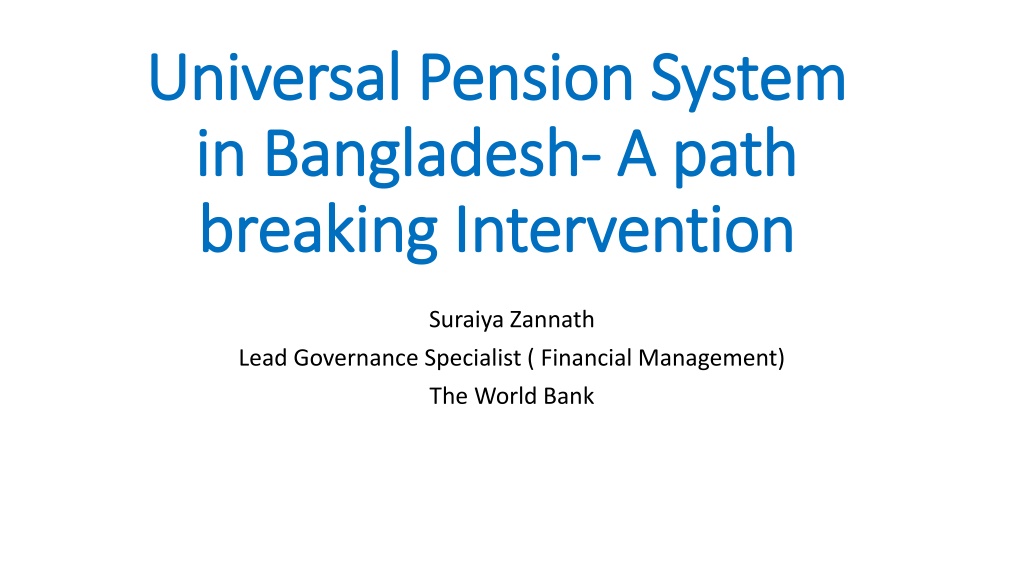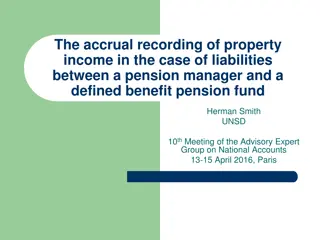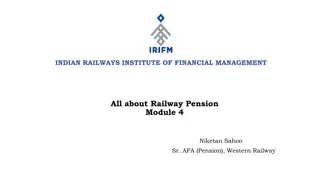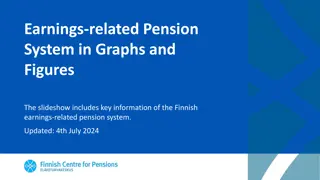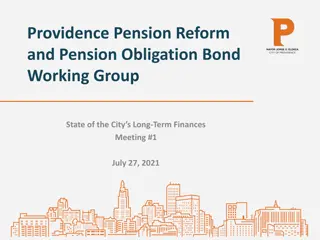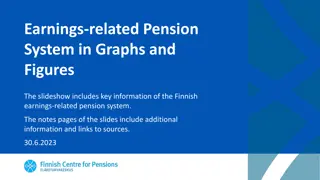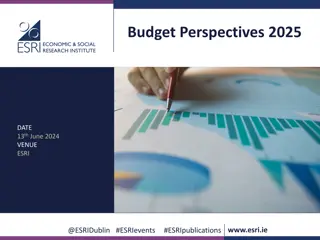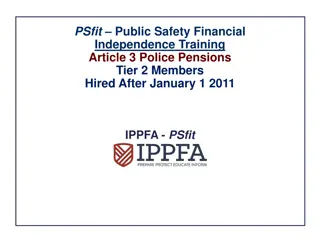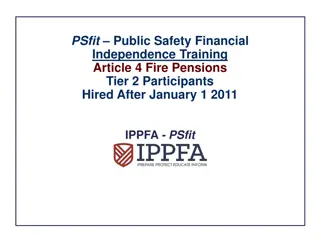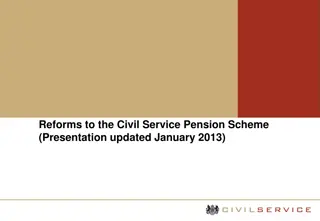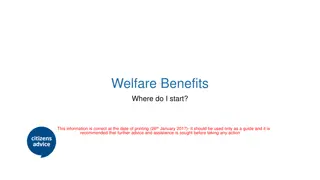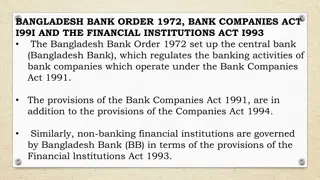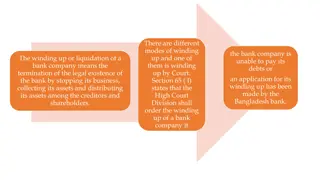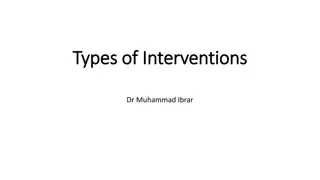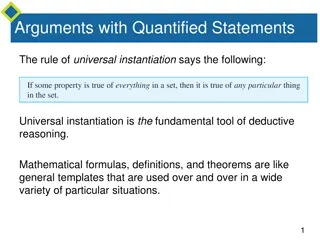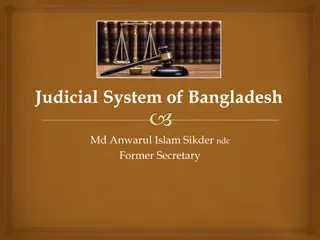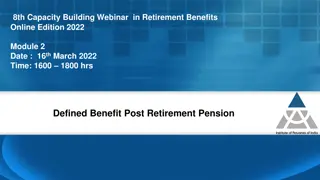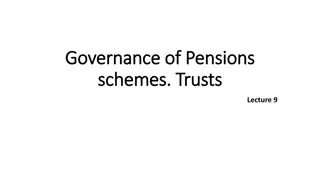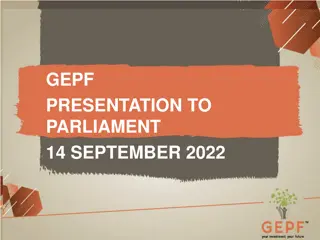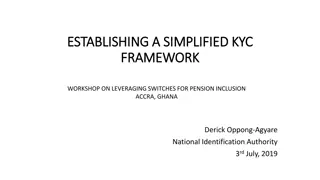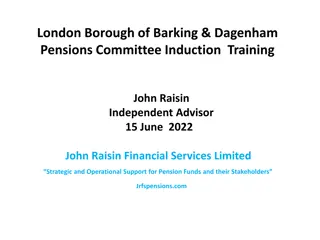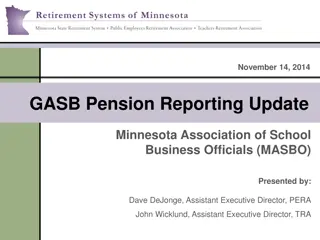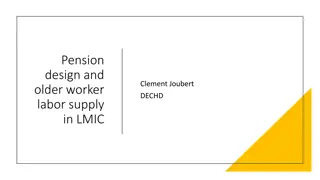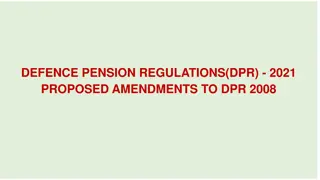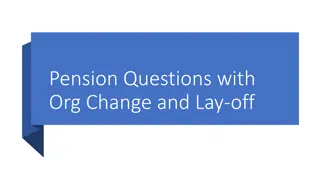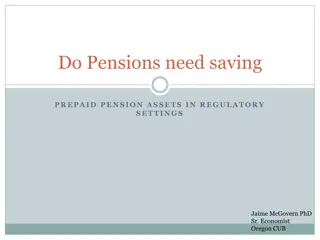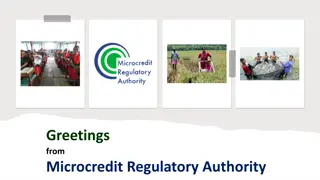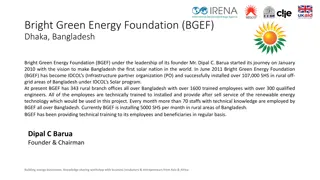Universal Pension System in Bangladesh: A Pathbreaking Intervention
Bangladesh offers a defined benefit pension system largely focused on civil servants. Efforts are being made to transition towards a universal participatory pension system through legal, institutional, and administrative reforms. The current system covers only a small percentage of the population, with plans to expand coverage to include the elderly, destitute, private sector employees, and more. The pension scheme is non-contributory and funded from the government's recurrent budget, with rising pension expenditure in recent years.
Uploaded on Sep 28, 2024 | 0 Views
Download Presentation

Please find below an Image/Link to download the presentation.
The content on the website is provided AS IS for your information and personal use only. It may not be sold, licensed, or shared on other websites without obtaining consent from the author. Download presentation by click this link. If you encounter any issues during the download, it is possible that the publisher has removed the file from their server.
E N D
Presentation Transcript
Universal Pension System Universal Pension System in Bangladesh in Bangladesh- - A path breaking Intervention breaking Intervention A path Suraiya Zannath Lead Governance Specialist ( Financial Management) The World Bank
Highlights Highlights Focused largely on Civil Service Pension, not broader pension reform efforts aimed at moving towards a universal participatory pension system. Legal, Institutional and Administrative Framework: Baseline data & information Reform & Progress Challenges & Way forward
Bangladesh offers a bountiful of defined benefit (DB) pension to its civil servants Legal, Pension system is based on the Pension Act of 1871 with additional amendments. The pension rules (Further Simplification of Pension Rules & Procedures in respect of Sanction and Payment of Pension to Civil Employees of Government) January 27, 2009. It expanded the coverage of the government employees pension scheme and mapped out budgeting and administrative arrangements The National Social Security Strategy (NSSS) 2015 proposes a comprehensive pension reform program towards a Universal Participatory Pension System that is fully funded, covering the elderly and destitute, private sector salaried and informal workers, and public sector employees. Institutional and Administrative Framework Bangladesh follows the traditional pay-as-you-go (PAYG) pension scheme, which is an unfunded and noncontributory, financed from the GoB s recurrent ( Non- Development) budget. The pension budget is formulated based on estimates of retirees and their benefits (adjusted for inflation). Pension expenditure is allocated in operating budget, and committed pension liabilities are a mandatory payable obligation of the GoB. Pension expenditure constituted 6.5 percent of current expenditure in FY16 and continues to grow. Pension expenditure rose from Tk. 106.3 billion in FY16 to Tk. 126.7 billion in FY17, and the allocation increased further to Tk. 229.4 billion in the FY18 budget, or 9.8 percent of current expenditure. .
At present, no formal pension system in Bangladesh at a national scale, except government service (civil and military). The number of government employees are around 1.4 million, which accounts for only 5% of the total employed (private and government) population. About 618,000 pensioners currently receiving benefits under the Civil Service Pension Scheme (excluding pensioners in entities such as railways, defense and postal services). Legal, Institutional and Civil Service Pension Scheme does not cover pensioners from numerous public sector organizations, semi-government agencies, autonomous bodies under ministries, local authorities, and government-aided educational institutions that are also entitled to pension and retirement benefits. Administrative Framework The retirement age is set at 59, and about 40,000 government employees retire every year out of a civil service of around 850,000. Three bodies are responsible for managing the pension processes: the department from where the employee retired, the Pay and Accounts Offices at the Ministry level (supervised by the Office of the Controller General of Accounts in the FD of the MoF), and the state-owned Bank that makes pension payments. Civil servants include gazetted and non- gazetted officers, except defense, whose pension is also fully funded but follows separate policies and procedures.
Under the Civil Service Pension Scheme, a pension is granted to a retiring civil servant based on the length of qualifying service and the last emoluments drawn. Legal, Institutional and Administrative Framework The defined benefit is an entitlement for the rest of the life of the civil servant, with a family pension going to the surviving spouse. The various categories of pensions and other benefits are :
Baseline data & information Several reports, analysis and survey stressed the need to modernize the administration of civil service pensions. FinanceDivisionoftheMOF sinitiativetointegratepayrollandpersonnelrecords,andthepolicynotecompleted in2015ontheIntegratedBudgetandAccountingSystem(iBAS++)highlighttheneedtoensureinternalcontrols forpayrollandpensionpayments. FD s initiative linking the payroll and pension databases to the NID system as part of the 2015 pay revision- a majorimpactincleaninguptherollsandremoving ghostpensioners . The PFM Reform Strategy 2016-2022 approved by the Finance Minister included modernization of the civil servicepensionadministrationsystemisakeypillaroftheGoB sPFMreformagenda. The Public Expenditure and Financial Accountability (PEFA) Report 2015 points to weak controls over the currentstockofcivilservantspensionsystem and A WB policy note on Bangladesh s civil service pension administration system proposed four priority actions Strengthened administrative arrangements by establishing a Central Pension Cell, simplified processes accounting and payment system, clear the backlog of pension cases. expand payment options, and automation and Increased responsiveness through Grievance redressal system.
Bangladesh: Improving the Administration of Civil Service Pensions
Fractured administration of pensions involving numerous agencies and systems. Pension processing and payment involved 20 steps- 17 steps to get a pension payment order /first payment, and another 3 steps to regular payments. Preparation of pension cases proceeds on the basis of extensive documentation. Manual verification is a time-consuming process. Some documents such as appointment letter issued at the time of employment (often decades earlier), a declaration of allegiance to the nation, and birth certificate are no longer relevant to pension processing; Baseline data & information Issuing the PPO is crucial activity before the payment is made; PPOs carry hand-written instructions, issued manually without a unique code or PPO number. This increases risk of malfeasance, multiple PPOs with different numbers and geographical locations and PPOs for ghost retirees.. Average time taken from the initiation of a claim to actual payment of a pension is 6 to 12 months, there are cases where pensions remain unpaid for years. Pensioners typically travel each month to accounts offices and banks to collect their pensions. Substantial back-log of pending pension cases mainly due to tedious manual processing and weak accountability mechanisms at each level. Risk or opportunities for rent-seeking with pensioners paying to facilitate or speed-up processing remains a big challenge. The system does not specify service standards of various entities involved in pension processing, including accountability to a timeline to dispose of pending cases
The Office of the Controller General of Accounts (OCGA), the authoritative body dealing with pensions, has limited capacity to control and monitor the entire process leading to backlogs and delays and compromising on the basic principles of internal control. Complete audit by Accounts Offices is duplication of work flow as it involved the same verification performed at the previous stage. The activities include: verification of all documents as forwarded by the Controlling Office; vetting and verification of credentials of the retiring employee, including the service book/record and the past pay fixations; verification of the pension calculation; and issuance of calculations in the form of a final report on pension, gratuity, and commutation. A major factor contributing to delays in pension processing is the lack of integration and full automation of different human resources systems for payroll. Employee self-fixation sheet, personnel records maintained at the ministry/division level Personnel database kept by the Ministry of Public Administration. Pull data from the various platform and automated systems to enable the preparation of PPOs (linked to the NID) and family pensions. Baseline data & information The pension calculation follows a pre-defined formula i.e. verification of the service records, qualifying service as well as regular pay fixations have to be incorporated in the calculation of the pension amount- the processes performed manually by using a calculator at the Accounts Offices. The system is prone to miscalculation, inaccuracy and error. Checks and balances in the system need strengthening by separating the functions of pension case preparation and issuance of PPOs for pension payment. At least two separate wings are needed to process pensions. The CPC for processing the pension case, make the pension calculations, prepare the final report, and issue the PPO. The Accounts Office responsible for identification and release of payment to the pensioner. Despite PPO issuance- payment of family pension commences on receipt of the pensioner s death certificate and additional processes, multiple documents such as finger prints, signatures, photographs, proof of date of birth, an affidavit indicating the names before marriage (if there is change in the surname after marriage), and bank account details.
For pension payments made through Sate owned Banks, the GoB pays substantial fees. The commission for making pension payments is about Taka 200 million per year, which at present rates would rise to Taka 1 billion if all pensioners drew their pension from Bank. Baseline data Baseline data & information & information Pensioners difficulty in obtaining and familiarizing themselves with pension rules and regulations; Readily available information about pensioners rights and responsibilities was missing. Ineffective Grievance redressal and limited scope to provide feedback.
Progress- Foundations of Reforms A modern and efficient pension administration and management system directly contributes to improved services to civil servants. As pension constitutes a considerable size of public expenditure, a well-administered pension system also contributes to efficient fiscal management and reduces the risk of system loss. In addition, civil servants become the direct beneficiary of reforms that have been implemented over the decades in the area of PFM system and institutions. The Government of Bangladesh (GoB) remains commited to modernize the pension payroll and administration as part of its commitment to achieve good governance and efficient service delivery in all areas. In Para 200 of Budget Speech of FY 2019-20 Finance Minister stated that the Government is planning to bring all pensioners under its pension payment process--Electronic Fund Transfer (EFT). A system has already been introduced so that pensioners (retired govt. employees) could automatically get their pension in their bank or mobile account without any physical presence in any accounts office or any bank. PFM- Program for Result - Strengthening Public Financial Management Program to enable Service Delivery includes improving pension management system and defined results indicator: Goal 3: Promote the efficient use of public resources and delivery of services through better budget execution
Reform & Progress over baseline Improved pension service (disaggregated by gender) through facilitation of payments through EFT no later than the pension payment cycle after retirement A full-fledged centralized pension roll with EFT payment capability has been established and is operational The CAO-Pension and Fund Management (CAO-P&FM) office established in 2018
The GoB succeeded to provide pensioners improved service through 100 percent Electronic Funds Transfer (EFT) and introduced many impressive policy and operational reforms. 547,428 number of pensioners have been brought under complete EFT coverage which represents 100% of existing pensioner. New pensioners receive their first Monthly pension through EFT after the date of retirement since September 2019. 542 Pay points are now sending EFT and 283,030 number of pensioners have been brought under the administration of CAFO-P&FM. Reform & Progress over baseline
Reform & Progress over baseline An automated Pension module has been developed and embedded in the iBAS++ system for all types of Pensioners (Existing, Family, and Unregistered). Pensioner receives monthly bills and a system generated SMS system to notice them about their payment. CAFO-P&FM has launched website that includes all necessary information for pensioner. Easy access to the website and check accuracy of payment through Pension Calculator. Pension related updates or general information are also shared through SMS, Website and publication in the newspaper. An active help desk to support pensioner in any pension related issues. A web-based grievance and redressal system (www.cafop&fm.gov.bd)is in place. The office of CAFO- P&FM is authorized to monitor and resolve complaints and provide feedback to stakeholders.
Automated and Integrated system: Implementation of National Pay Scale Revision in 2015- employees were required to register new fixation sheets online with NIDs, leveraging on the Bangladesh Computer Council connectivity backbone (BanglaGovNet). Pension rolls dropped dramatically The GoB used the opportunity to validate the rolls using the NID for pensioner authentication and curbing the presence of ghost pensioners . This was a major step Reform & Progress over baseline Establishing a comprehensive pension database that is integrated with employee records and payroll. Ensuring the validity of employees transiting to the pension database from the regular payrolls after systematic reconciliation with the payrolls, personnel records maintained at the ministry/division level, and employee database kept by the Ministry of Public Administration. To ensure the integrity of the system, comprehensive and centralized pension database capturing personnel information including departmental affiliation, grade, service conditions and payroll information of all government employees and pensioners.
Pensioners, GPF accounts holders and other stakeholders already lodged complaints through this new website and CAFO-P&FM are authorized to verify all the issues. Evidences regarding the issues that was resolved by CAFO- P&FM are submitted to the OCAG for authentication. Live verification process is ensured currently through NID system A system of face recognition through mobile application is in progress. Issuing eppo card to the pensioner is in process. Reform & Progress over baseline To raise awareness on new streamline and expedited pension processing procedures, several outreach programs are planned including use of communication tools such as electronic and social media. Call Center: About to launch (Long No# 0960900055, Short Number will be communicated later)
Topic Impact DLI focuses on improved pension service (disaggregated by gender) through the EFT no later than the following pension payment cycle after retirement. DLI would most directly benefit the vulnerable, the poor, disabled, women, and the elderly, and indigenous people at large through improved pension service. This will also create employment opportunities. Both male and female civil servant pensioners are covered by the non- contributory defined pension scheme and draw pensions following a uniform policy and processes. Cumbersome and complex official processes and unnecessary documentary requirements to accessing pensions (which affect both women and men) impinge more heavily on women due to women s lower access to information and financial, time, and mobility constraints as well as socio-cultural norms and purdah practices, and potential exposure to harassment and corruption through bureaucratic processes. Employment Impact & Impact & Outcome Outcome Broader Broader Economic, Economic, social social perspective perspective Women and Children Having an automated system such as EFT reduces above hurdles which women commonly face and facilitate easier access to pension benefits, particularly benefit family pension recipients as widows of pensioners have to undergo a number of additional processes to claim family pensions. A few indicators measure progress in gender equality in access to pensions.
Impact & Outcome Impact & Outcome Broader Economic, social perspective Broader Economic, social perspective Poverty Reduction An analysis of PEFA indicators around the world shows that countries with better PFM have higher per capita income and have more capable governments serving their people. Higher growth is likely to lead to increased employment opportunities and reduction in poverty. SPFMS will enable additional funding for the social sectors including the social protection expenditures for poverty reduction. Reduction Regional Disparity of Improved PFM enables better targeting of poverty reduction expenditures to reduce regional disparity Climate Change DLI 5 is supported by the evolving ecosystem of electronic and mobile payments. It is pertinent to note here that mobile telephone and Internet accessibility by the citizens have improved over the years. Retirees and people under social vulnerable/indigenous people/elderly and women benefit from receiving pensions through their bank account or through using mobile money transfer apps such as BIKASH, ROCKET, and like other means near their abode. This reduces the use of paper, thus improving the environment owing to less felling of trees and so on. safety net program including
Governments Commitment towards Universal Pension: The workforce is shrinking, and the cohort of pensioners are growing, the burden of pension expenditure on the exchequer is also burgeoning leaps and bounds. With higher longevity and greater life expectancy the pension expenses are likely to grow further, and the implicit pension debt may reach a very high number as a percentage of GDP. Challenges & Way forward: (The number of people over 60 years of age has been projected to increase from about 9.8 million (6.5% of total population) to 18.1 million (10% of total population) by 2026 and 44.1 million people (20.2% of total population) by 2051 in Bangladesh. The average life expectancy of a Bangladeshi is now around 70 years, which will result in an increased dependency ratio and declining potential support ratio.) The overall DB pensions for the civil servant under the PAYGO system may therefore not be sustainable in the long run and hence require systemic changes in the form of pre funding of pension liabilities by govt or self-contributions
The increasing life expectancy, coupled with the gradual disappearance of the extended family system, makes it imperative for Bangladesh to design a robust pension system to avoid impoverishment in old-age and accompanying social distress. Timely and smart policy interventions, when a majority of the Bangladesh population is still young, can help avert an impending pension crisis. A fully funded pension system, with options of investment in stock or bonds Form a pension management & Advisory body (or assign to investment Bank) - to oversee universal pension system, formal- informal. Challenges & Way Keeping reform momentum going is critical-- forward: Strengthen oversight system pay roll and pension audit Verification process- whether the pensioner is alive! NID verification through iBAS++ at any accounts office Face recognition through Mobile App Issuing e-PPO card to the pensioners Make Pension Processes shared responsibility, identify the root causes for delayed processes and payment at various tiers and develop service standard barring legal/tribunal issues. Communication strategy is crucial -Progress on this agenda will require addressing a range of motivational issues, promoting an enabling environment to manage emerging challenges, encouraging solution focused leadership, and embarking on a communication campaign to explain the benefits of the proposed reforms
Universal pension is a stream of payments from state to an individual that starts when someone retires and continues in payment until he/she dies. It is a part of a pension system of most developed countries, specifically the so called zero or first pillar of the pension system. The Universal pension is different from other types of pension since its eligibility criteria do not require former contributions of an individual, but his citizenship or residency and age or other criteria set by government. In Para 202 of Budget Speech of FY 2019-20 Finance Minister announced an Introduction of Universal Pension Scheme with the rationale to provide wider coverage. According to the speech, since the Government pensioners are only a small fraction of the total population, a wider coverage is envisaged by the Government. The para also suggested formation of an Authority for gradual introduction of the universal pension for everyone including all employed in formal and informal sectors of the economy. Progress towards Universal Pension system:
